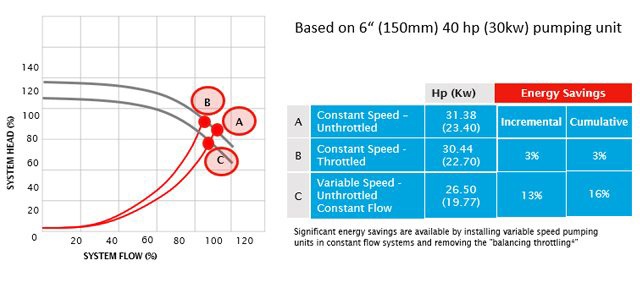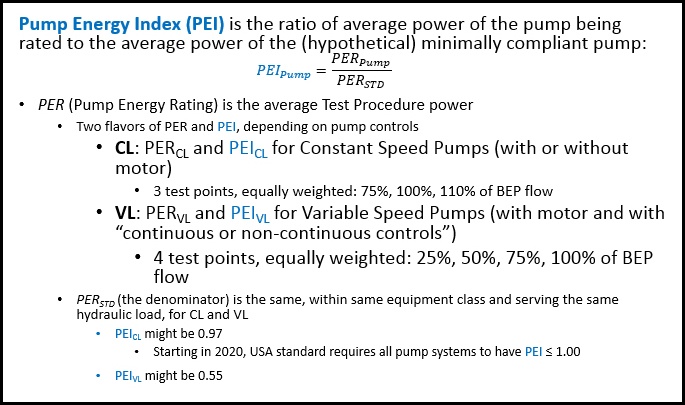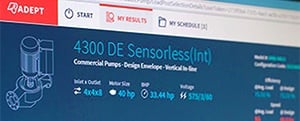As seen on empoweringpumps – March 07, 2017

Author: Brent Ross, Director, Armstrong Fluid Technology
There is a misconception in the HVAC marketplace that needs to be addressed. Unfortunately, many people believe they only need variable speed when they have variable flow applications. This might be because the recently updated ASHRAE 90.1 2016 rules essentially do not require variable speed in constant flow applications. ASHRAE 90.1 is a minimum requirement, and if there are ways to save more energy than what is required as a “minimum”, we should absolutely be trying to save more energy than what is minimally required. Using variable speed in constant flow systems, the HVAC industry has an opportunity to save an average of 15 to 16% energy and sometimes over 50% and more.
HOW does variable speed save a 15-16% average of energy in constant flow systems?
The main reason why constant flow systems DO need variable speed is because pump system designs are estimates of the pressure required; these estimates include safety factors. When an engineer estimates the pressure required in a system, they figure in a variety of safety factors to allow for a range of issues: they allow for problems on-site where a pipe might have to be much longer than the straight line drawing assumed; they allow for pipes getting older over time and rust occurring; they allow for smaller valves being used than what was originally estimated, etc. There is a tremendous amount of safety factor included in the HVAC pumping system designs. It’s a conservative estimate to say, on average, there is a 15% percent safety factor allowed in head in these constant flow systems. That 15% safety factor means the pump will operate forever wasting 15% of the energy; but by putting in variable speed controls, you don’t have to waste that 15% energy. You can consume the proper amount of energy and still have your pump system designs with the proper amount of safety factors included.
In Figure 1 above, a typical pumping system can be seen at point B where it is operating at the head and flow that the end user specified. However, when the pump is first turned on, the actual system head is usually lower due to safety factors. To get to that flow point, the end user has to throttle and waste energy (throttling can be carried out by opening and closing a discharge valve and is energy inefficient since the energy to the pump is only slightly reduced; most energy is wasted by increasing the dynamic loss).
There is an opportunity, however, namely a Variable Load (VL) rated pump with controls, which is capable of operating at a constant reduced speed that can go from point A to point C without throttling and wasting energy (and running at a constant reduced speed saving 16% energy). This, then, is the opportunity to use VL pumps and save energy in “constant flow” commercial HVAC applications.
Another advantage of using VL rated pumps with controls is that the installation is “future-proofed”. Most major constant flow applications today such as Primary heating or cooling or condenser water systems have control systems available that can make them variable flow and save substantially more energy. The designer or user may choose not to install these control systems initially but an energy upgrade sometime in the future is often done. If VL rated pumps with controls are used initially they are ready to go with an energy upgraded control system in the future!
Be careful not to confuse the terminology. The U.S. DOE 2020 rule defines CL (Constant Load) as the “Pump + Motor” and the VL (Variable Load) as the “Pump + Motor + Continuous or Non-continuous Control”. The U.S. DOE rule does not define specific applications applicable to each one, only the components used. For this reason, people may not realize the value of VL rated pumps and erroneously incent Constant Load CL pumps. We should really incent the use of Variable Load VL pumps ONLY!
The good news is that the Hydraulic Institute (HI) just introduced a Pump Energy Rating System (see Figure 2 below) which will be in accordance with the U.S. DOE 2020 ruling. What do the ratings tell the marketplace? The ratings will enable the marketplace to compare Constant Load pumps (CL) with Variable Load pumps (VL).

Figure 2. The Pump Energy Index (PEI) is a rating scale that works with the U.S. DOE’s 2020 rule, which will make any pump with the rating over 1 illegal to sell by a pump manufacturer. The CL ratings will be in the neighborhood of .97 while the VL ratings will be in the neighborhood of .55 – which demonstrates the tremendous energy savings potential between the VL rating and the CL rating.
A VL rated pump has tremendous value in a constant flow system. If anyone has questions about this, please use the Industry Forum to continue the conversation.
Check out the Hydraulic Institute Pump Energy Index (PEI) Calculator.



